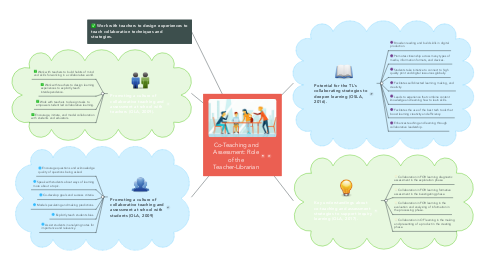Co-Teaching and Assessment: Role of the Teacher-Librarian
by Carey Campbell

1. Work with teachers to design experiences to teach collaboration techniques and strategies.
2. Promoting a culture of collaborative teaching and assessment at school with teachers (OLA, 2009).
2.1. Work with teachers to build habits of mind and skills for working in a collaborative world.
2.2. Work with teachers to design learning experiences to explicitly teach interdependence.
2.3. Work with teachers to design tasks to empower student led collaborative learning.
2.4. Encourage, initiate, and model collaboration with students and educators.
3. Potential for the TL's collaborating strategies to deepen learning (OSLA, 2016).
3.1. Broaden reading and build skills in digital production.
3.2. Promotes citizenship across many types of media, information formats, and devices.
3.3. Students take initiative to connect to high quality print and digital resources globally.
3.4. Facilitates self-directed learning, making, and creativity.
3.5. Leads to experience that combine content knowledge and learning how to learn skills.
3.6. Facilitates the use of the best tech tools that boost learning creativity and efficiency.
3.7. Enhances teaching and learning through collaborative leadership.
4. Promoting a culture of collaborative teaching and assessment at school with students (OLA, 2009)
4.1. Encourage questions and acknowledge quality of questions being asked.
4.2. Speak with students about ways of learning more about a topic.
4.3. Co-develop goals and success criteria.
4.4. Model speculating and making predictions.
4.5. Explicitly teach students bias.
4.6. Assist students in analyzing notes for importance and relevancy.
5. Key understandings about co-teaching and assessment strategies to support inquiry learning (OLA, 2017).
5.1. Collaboration in FOR learning diagnostic assessment in the exploration phase.
5.2. Collaboration in FOR learning formative assessment in the investigating phase.
5.3. Collaboration in FOR learning in the evaluation and analyzing of information in the processing phase.
5.4. Collaboration in OF learning in the making and presenting of a product in the creating phase.


